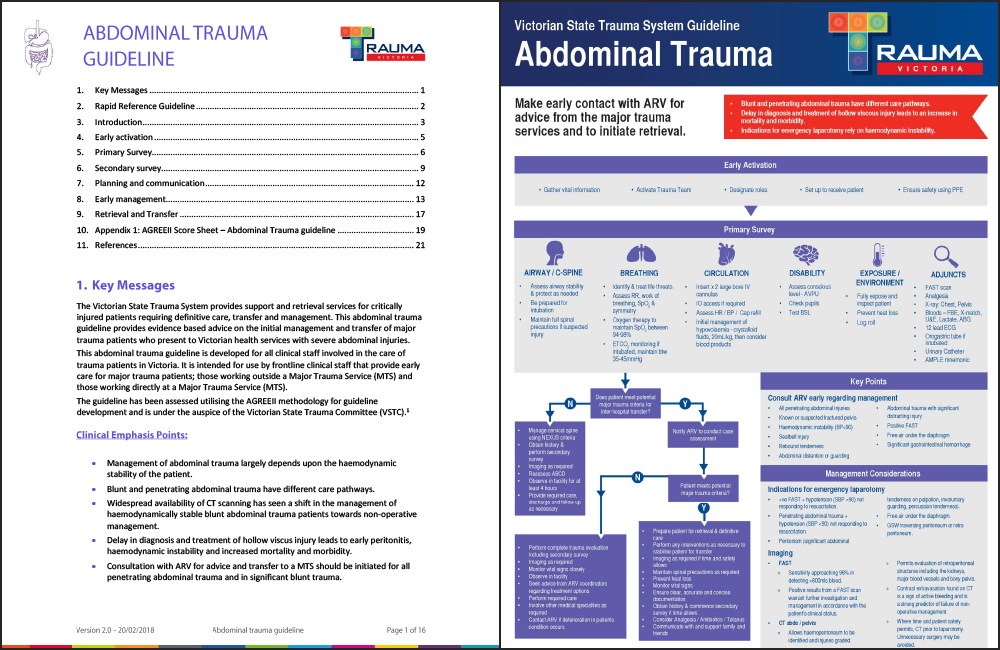
Victorian State Trauma System; Abdominal Trauma Guidelines
The Victorian State Trauma System provides support and retrieval services for critically injured patients requiring definitive care, transfer and management. This abdominal trauma guideline provides evidence based advice on the initial management and transfer of major trauma patients who present to Victorian health services with severe abdominal injuries.
This abdominal trauma guideline is developed for all clinical staff involved in the care of trauma patients in Victoria. It is intended for use by frontline clinical staff that provide early care for major trauma patients; those working outside a Major Trauma Service (MTS) and those working directly at a Major Trauma Service (MTS).
The guideline has been assessed utilising the AGREEII methodology for guideline development and is under the auspice of the Victorian State Trauma Committee (VSTC).
- Management of abdominal trauma largely depends upon the haemodynamic stability of the patient.
- Blunt and penetrating abdominal trauma have different care pathways.
- Widespread availability of CT scanning has seen a shift in the management of haemodynamically stable blunt abdominal trauma patients towards non-operative management.
- Delay in diagnosis and treatment of hollow viscus injury leads to early peritonitis, haemodynamic instability and increased mortality and morbidity.
- Consultation with ARV for advice and transfer to a MTS should be initiated for all penetrating abdominal trauma and in significant blunt trauma.
Introduction
Abdominal trauma accounts for 22% of body regions injured in major trauma and can be difficult to diagnose and manage.2 A high index of suspicion should be maintained for any multi-trauma patient, particularly where the mechanism of injury may suggest significant abdominal injury. Understanding the types of injuries is important for the planning and organisation of trauma services. Penetrating injuries are frequently isolated injuries, but may cause severe organ or vessel disruption and rapid bleeding. Securing breathing and control of bleeding are often the priorities with this type of injury.
The vast majority (over 90%) of major trauma in Australia is caused by blunt injury mechanisms, such as those caused by motor vehicle collisions (MVC), falls, and being forcefully struck. Blunt injuries less often present with rapid exsanguination, but are more often associated with multiple organ failure, combinations of airway, breathing, circulatory, neurological and musculoskeletal deficiencies, and permanent physical and cognitive disabilities among survivors.
Missed abdominal injuries are a major cause of avoidable death in trauma patients.3 The principles of initial management focus on the detection of any injury and determining the need for urgent intervention. Investigations such as the Focused Assessment of Sonography in Trauma (FAST) and Computerised Tomography (CT) scanning can determine the presence of injuries in combination with assessment.
Specifications
- Last Updated: 2018
- Author(s): Victorian State Trauma System
- Category: Guidelines
- Tags: 2018, English, Victorian State Trauma System
PDF Documents
Please login to access file downloads.
